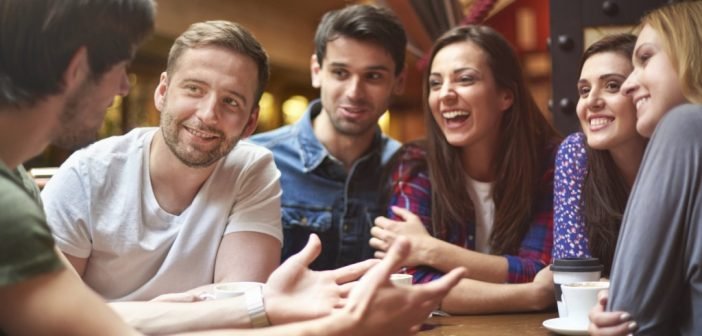There are 3 stages in love, and in each of them different hormones are activated. In addition, it has long been shown that the changes that occur in our brain when we fall in love are comparable to mental illness. But what about our body exactly? And why do some people like us more than others? Science gives its answers.

1. Text messages with a period at the end are perceived as liars and / or angry.
Scientists at Binghamton University in the United States, led by psychology professor Celia Klin, conducted an experiment with 126 students. They were given dialogues that consisted of 2 sentences: the first was a question; the second, different variations of responses that consisted of a single word such as "yes", "aha", "clear", etc. The main characteristic of the answers was the presence or absence of points at the end. Afterwards, the reading participants were asked to evaluate the degree of veracity of the answer and, surprisingly, in most cases the answers without points at the end were evaluated as sincere, and those that had the point, as false.
When we exchange text messages we can not receive nonverbal cues, such as facial expression, tone and volume of voice and body language. To replace them, there is every type of textual imitation: the capital letters and the exclamation marks when we shout and get angry, spelling mistakes deliberately committed when we try to show a lack of interest or that we are busy. The point is a sign of firmness and the intention to end the conversation, as explained by the professor of linguistics, Mark Liberman. That's why it seems to us that the person who puts it at the end of his answer is angry.
2. We behave better if it is what is expected of us.
According to the Pygmalion effect, we perceive people in a way that corresponds to our ideas about them. This, in turn, pushes people to behave in a way that confirms other people's expectations.
In an article published in Harvard Magazine, social psychologist Amy Cuddy explains: "If you think someone is an idiot, you treat them in a way that makes undesirable behavior manifest, and then you exclaim: 'See! I told you I was an idiot. ' This is one of the most dangerous mistakes that ultimately leads people to start believing in stereotypes and assigning labels. Although, in reality, the scheme is simple and everything comes from our own thoughts and beliefs, for example: 'I think thin people are bad → thin people irritate me in advance → the thin person behaves negatively' ".
Knowing this pattern, you can use it to your advantage and, depending on the situation, treat the person in such a way that they behave in the correct way.
3. We are attracted to people who have traits that we like in ourselves and traits that we lack.
This rule worked, it works and it will always work, although sometimes we do not stop to think about it. And it consists of two simple parts: we like people who have something that we like about ourselves; and in which there are positive qualities that overlap with what we hate in ourselves.
Let's see a simple example: a pretty young woman who is proud of her appearance, but hates the fact that she is too shy and withdrawn. She meets a man who is also handsome, but he is also very charismatic and self-confident. So much that it compensates for the insecurity of the young woman. This mixture of certain qualities makes it a perfect match for her, because they are similar and at the same time they do not look alike, so they complement each other.

4. We are more inclined to trust strangers who remind us of someone who once earned our trust.
A group of researchers from the United States conducted an experiment in which 29 participants had to make a choice: to keep 10 USD or to invest all (or one part) in one of the 3 strangers in the photographs. During a series of games, participants noticed that one of these men shared the benefits of the investments very often, the second from time to time and the third, very rarely.
Then the second part of the experiment began. The players were offered to choose a partner for the new game. Four people in the photos were new, while the remaining 54 photos were manipulated with Photoshop and the people in them became more or less similar to the players in the previous test.
As a result of the experiment, it became clear that the participants tended to choose as a partner people who resembled those with whom they had played the first time and who made a good impression. At the same time, more than 68% of participants rejected photos of players who had at least some external resemblance to the third man in the first game, who rarely shared the winnings and was not reliable.
5. Our brain can calculate the popularity of another person.
In practically all social groups, the popularity of one or other people determines the social status and connections. But how do we recognize that certain people are popular, even when collective preferences are different from our own tastes?
In a study published in the journal PNAS, the experts asked the volunteers to evaluate the degree of popularity of people in the photos of social networks. At the same time, the brain of the participants was carefully scanned. The result of the experiment was the understanding that when it comes to guessing the popularity of some members of a social group, certain areas of the brain are activated. That is to say that the degree of attractiveness of some people to others is determined by a specific neuronal system. This connects, for the solution of the problem, both the affective (emotional) evaluation and the systems of social cognition, which finally play a decisive role in the accuracy of the verdict.
6. We like it when we are perceived the way we want.
People want to be perceived according to their own ideas about themselves. We all seek confirmation of our points of view, positive or negative. This phenomenon has been tested many times in different universities: subjects with positive and negative perceptions of themselves were asked who they would like to talk to, with people who have a positive impression of them or a negative one.
Participants with a positive image of themselves preferred people who thought well of them, while others preferred critics. This is because people like to deal with those who provide comments that correspond to their self-identification. Therefore, if the idea that the other person has of us is combined with ours, communication develops without problems, because we feel understood.
7. The more symmetrical the appearance of a person, the more beautiful it will look to us.
When looking at a beautiful person, hardly exclames: "Wow, it's so symmetrical!". However, many studies confirm that the symmetry of the face and body play an important role in how attractive a person is. Of course, there is no completely symmetric person, because biology is not perfect. However, it has been scientifically proven that the lower the level of oxidative stress (consisting of the accumulation of harmful active agents, so-called free radicals) in humans, the more symmetrical they will be.
An article in The Independent tells about an experiment in which, to evaluate the symmetry in the appearance of several men, 10 very different parameters were taken into account, from the height of the ears to the length of the fingers. Then tests were done to evaluate the level of stress mentioned above. Finally, a group of women was asked to evaluate the photos of the subjects according to their physical attractiveness. As a result, men with the most symmetrical indicators and with the lowest level of stress were considered the most handsome.
Follow me and do not forget to vote! Until the next post!
